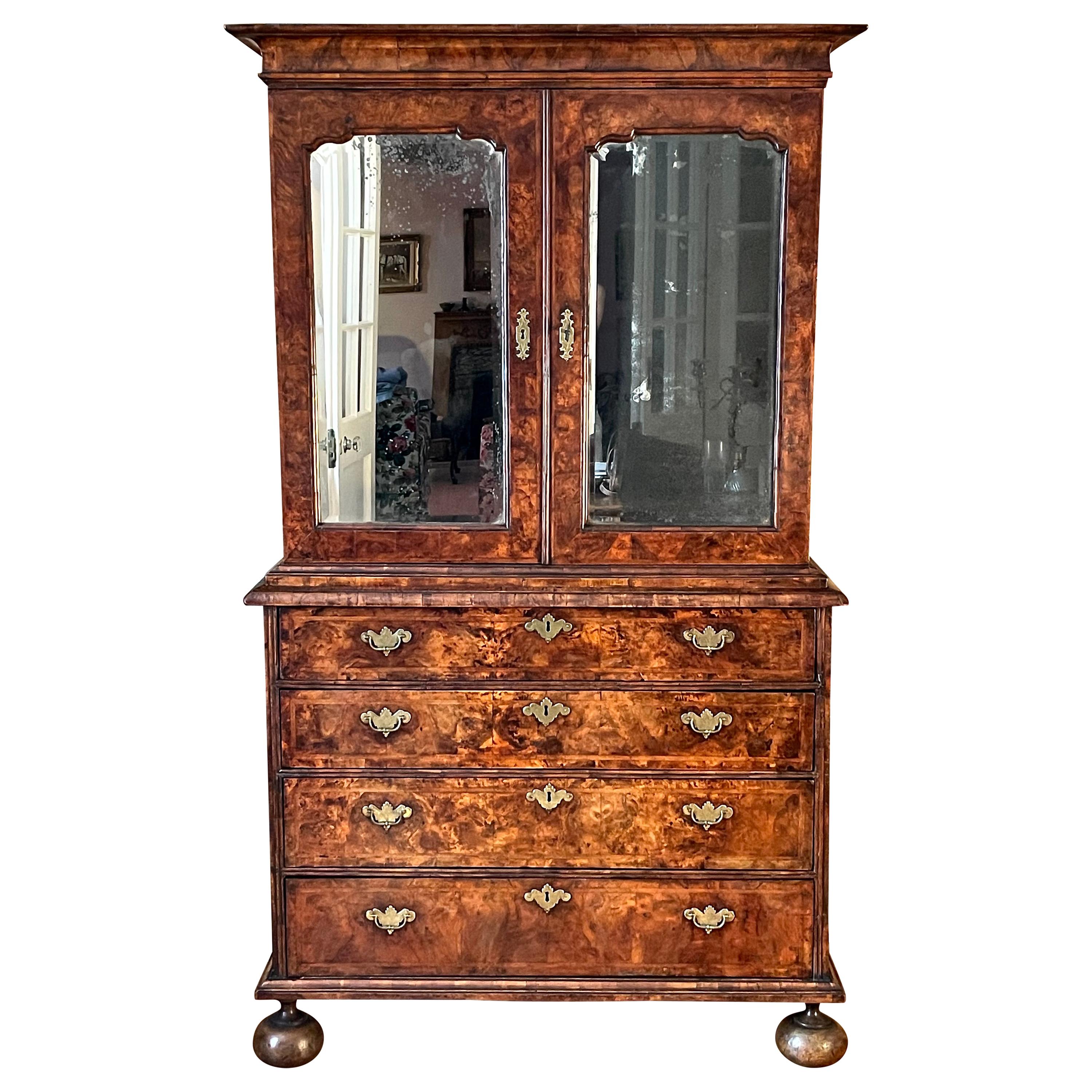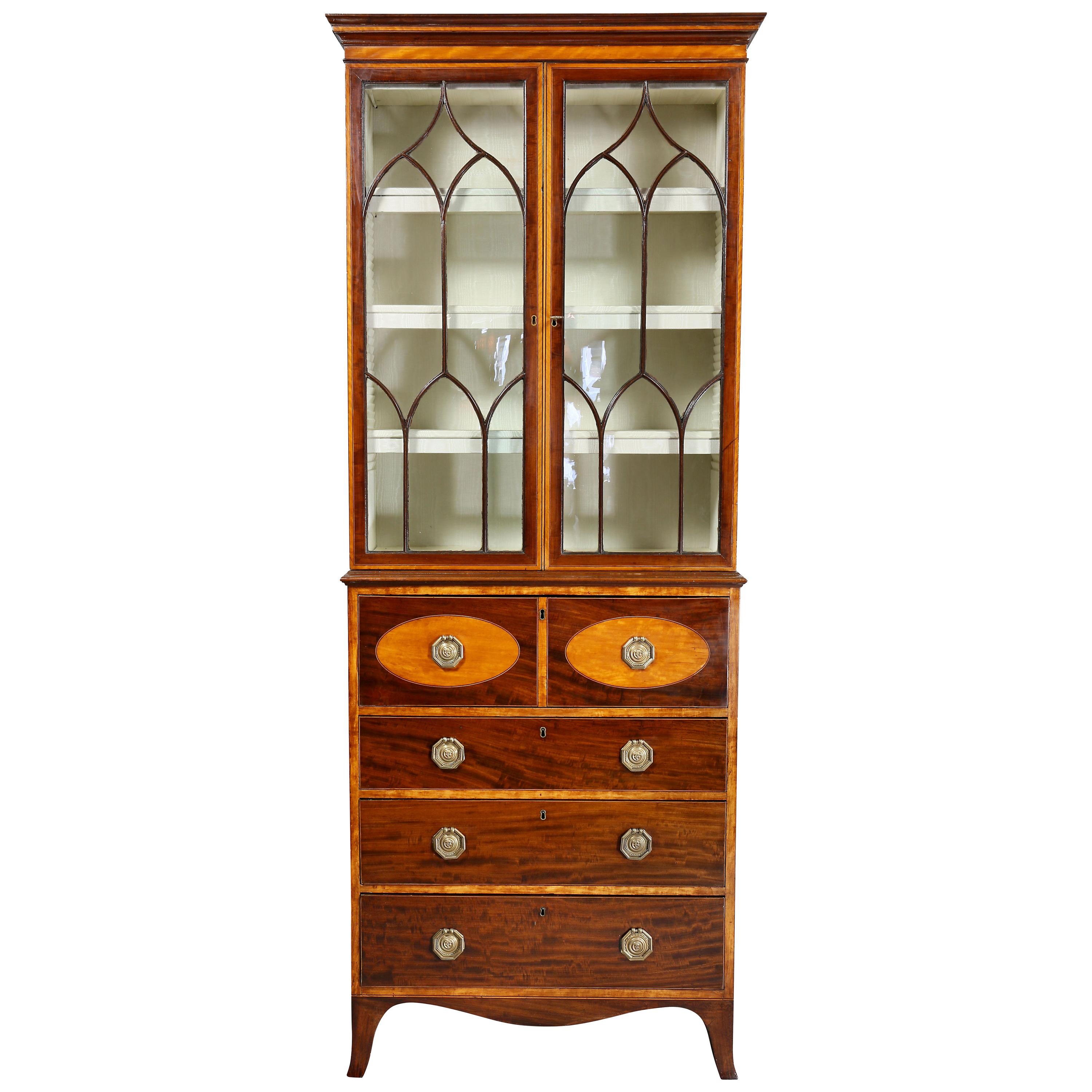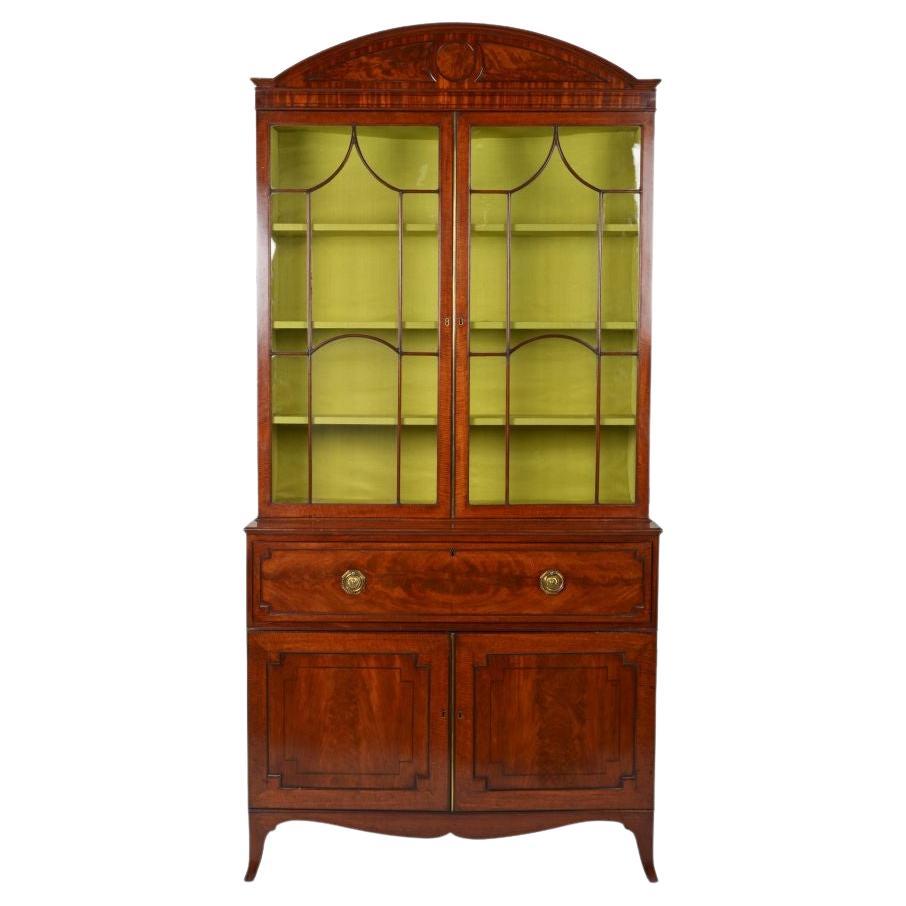Items Similar to Fine George III Period Satinwood Secretaire Cabinet
Video Loading
Want more images or videos?
Request additional images or videos from the seller
1 of 10
Fine George III Period Satinwood Secretaire Cabinet
About the Item
An exceptional English Sheraton period satinwood secretaire cabinet. Attributed to Gillows.
Late-18th century, George III, ca 1790.
Measures:
H 59 1/2’’ (151 cm)
W 30’’ (76 cm)
D 19’’ (49 cm).
This small, beautifully-proportioned, and sophisticated antique writing cabinet (without doubt by the prestigious firm of Gillows & Co) is in well-figured West Indian satinwood all of the highest quality, with lovely colour and surface patination throughout.
The top detachable section contains three adjustable shelves.
The base has a pull-out writing section with an arrangement of small drawers and pigeon holes. Sandalwood linings.
Two cupboards below – with adjustable shelving within – flanked by gently tapering, reeded columns.
In perfect condition throughout and ready to use.
Gillows of Lancaster and London, also known as Gillow & Co., was an English furniture-making firm based in Lancaster, Lancashire, and London.
Literature:
Lindsay Boynton 'Gillow furniture designs, 1760-1800' (1999).
Gillows: a record of a furnishing firm during two centuries by Gillow & Co.
Examples of furniture & decoration by Gillows by Waring & Gillow (London) 1908.
Sarah C. Nichols 'Gillow and Company of Lancaster, England: an eighteenth-century business history' (1982).
M. E. Burkett 'The furniture of Gillow of Lancaster' (1971).
- Dimensions:Height: 59.45 in (151 cm)Width: 29.93 in (76 cm)Depth: 19.3 in (49 cm)
- Style:George III (Of the Period)
- Materials and Techniques:
- Place of Origin:
- Period:
- Date of Manufacture:circa 1790
- Condition:Repaired: Minor historic re-attachment of old veneers. Very skilfully executed indeed. Now in superb condition throughout and ready to use. Wear consistent with age and use. Minor historic re-attachment of old veneers. Very skilfully executed. Now in perfect condition throughout and ready to use.
- Seller Location:Lymington, GB
- Reference Number:
About the Seller
5.0
Vetted Seller
These experienced sellers undergo a comprehensive evaluation by our team of in-house experts.
Established in 1957
1stDibs seller since 2018
33 sales on 1stDibs
Typical response time: 19 hours
- ShippingRetrieving quote...Ships From: Lymington, United Kingdom
- Return PolicyA return for this item may be initiated within 14 days of delivery.
More From This SellerView All
- Fine George I Burr Walnut Secretaire CabinetLocated in Lymington, GBA fine English George I-period burr (burl) walnut secretaire cabinet. Early-18th century, ca 1720. The top section separates from the base and opens to reveal numerous fitted drawers, behind doors with original bevelled arched mirror plates. The base contains a fall-front fitted secretaire with small drawers, two of which have secret drawers. Engraved mounts are contemporary if not original. All locks and cross-grained mouldings are original. Beautiful colour throughout with superb matched burr veneers within herringbone lines. Bun feet are original. Lined throughout in best quality English oak. The well-patinated green, gilt-tooled liner in the writing surface appears original. Very much in the style of John Old & William Ody. One of the most original early-18th century pieces of English walnut cabinet...Category
Antique 18th Century English George I Cabinets
MaterialsWalnut
- 18th Century Mahogany Secretaire Bookcase China CabinetLocated in Lymington, GBA fine English mid-18th century mahogany secretaire / secretary / bookcase / china cabinet. Of lovely, deep, rich color, patina and quality. George III period, circa 1760. The bold, detachable, swan-neck pediment carved with 'Gothic' open fretwork, spiral rosettes and a dentil cornice. The pediment is centred by a small platform below which is a fluted panel. The bookcase / china cabinet section with two, thirteen-pane glazed doors, with three original adjustable shelves with applied beadings for the display of china etc. The base with a pull-out writing section fitted with small drawers, two of which have secret releases. These secret drawers are faced with blind-fret 'Gothic' tracery, and centred by a carved, shaped arch. The base with three cock-beaded drawers, and raised on its original bracket feet which are faced with blind fret. This fine, sophisticated and well-proportioned example of a secretaire / secretary / cabinet / desk / bookcase is remarkable for having survived in its original state including all swan-neck handles and locks. Of superb quality, color, patination, and well figured throughout. With mahogany drawer linings: further confirmation of its quality. Measures: 42" wide (107 cm) 23" deep 58.5 cm) 95" high (241 cm) - without cartouche. A related antique bureau cabinet...Category
Antique 1740s English Cabinets
MaterialsMahogany
- George III Period Satinwood Pembroke TableLocated in Lymington, GBA late 18th century satinwood Pembroke table of very good rich color. George III period. The top crossbanded in satinwood, bordered with fine lozenges of ebony stringing. The edges ebonized with narrow mahogany crossbandings. Raised on moulded tapering legs, indicative of a date circa 1770. The frieze with two working mahogany-lined short drawers retaining the original gilt-brass Rococo mounts. The two leaves are supported on the original recessed hinged ‘ear’ supports. Overall in lovely original state. Some minor historic marks entirely commensurate with its age. Very good patination. These antique Pembroke tables were designed to be versatile: as small supper tables; occasional tables; tea tables; or lamp tables - sometimes also referred to as ‘drop leaf’ or ‘sofa’ tables. The majority of these Georgian tables are raised on square tapering legs or, when of a later date, on turned legs. It is more unusual for a satinwood Pembroke table to be raised on moulded tapering legs. Interestingly, Thomas Sheraton (1751-1806) mentions the Pembroke table as follows: “a type of breakfast table from the name of the lady who first gave orders for one of them”, possibly referring to the Countess of Pembroke, of Wilton House, Salisbury, (1737-1831). A similar George III satinwood Pembroke table...Category
Antique 1770s English Tables
MaterialsSatinwood
- Fine Chippendale Period Satinwood and Marquetry DeskLocated in Lymington, GBA fine Chippendale-period satinwood and marquetry desk. English, George III period, circa 1770. The considerable use of the best quality mahogany in the carcass is typical of the very fine work of Thomas Chippendale. It is rare today to find an 18th-century satinwood and marquetry-inlaid desk of this quality. (Most offered on the market are 19th/ 20th century). Major, period satinwood pieces have become almost unobtainable. The superbly-controlled and delicate marquetry inlays are reminiscent of the fine decoration on the famous Diana and Minerva Commode by Chippendale at Harewood House...Category
Antique 18th Century English George III Desks
MaterialsSatinwood
- George II Mahogany Bureau Cabinet BookcaseLocated in Lymington, GBA very impressive mahogany bureau cabinet / bookcase / secretary*, with secret compartments. In the manner of Giles Grendey (1693-1780). In mahogany and parcel gilt. Mid-18th century, George II period. This English bureau cabinet displays fine, deep, rich colour and superb surface patination throughout. The top section with a broken-arch pediment and dentil cornice. The frieze well carved with Gothic arcaded blind fretwork. Centred by a later urn-shaped finial. The cabinet with two carved parcel-gilt gesso bordered ogee shaped doors. Old but apparently later mirror plates enclosing a fitted interior with eight drawers and adjustable shelves. The cleated fall, with its original lock, now fitted with a wine red, gilt-tooled writing surface revealing an exceptionally high-quality arrangement of canopied drawers and pigeon holes. The interior is centred by an arched, architectural over door...Category
Antique 18th Century English George II Bookcases
MaterialsMahogany
- George II Mahogany Bureau Cabinet BookcaseLocated in Lymington, GBAn 18th-century mahogany bureau cabinet of impressive architectural form and lovely rich color. George II period, circa 1740. The top surmounted by a bold architectural pediment and centered by a brass finial. The two arched panel doors reveal three adjustable shelves which have candle slides below them. Furthermore, the bureau section is fitted with a stepped interior. This has two secret compartments, drawers and pigeon holes, and the fall is conventionally supported on two lopers. Lined in the best quality English oak. The blind doors of this Georgian cabinet have well-figured mahogany panels of very good rich color which reflect beautifully in the candle light. The chamfered and arched doors display a further level of sophistication and quality. The beautifully-drawn arched pediment is in perfect proportion with the rest of the cabinet / bookcase. In excellent condition overall. Architectural furniture designs on the continent commenced with the arrival of the Renaissance, and they have their origins in Roman and Greek architecture. Nb. Bureau bookcases display books, china or silver behind glazed doors, but are described more accurately as bureau cabinets when they are fitted with blind doors. We often refer to antique bookcases / cabinets as ''secretary desks'' in the US. Information on pediments: 'Illustrated Dictionary...Category
Antique 1740s English George II Cabinets
MaterialsGlass, Mahogany
You May Also Like
- A fine late George III satinwood and snakewood secretaire cabinetBy George SimsonLocated in Lymington, HampshireA fine late George III satinwood and snakewood secretaire cabinet, attributed to George Simson of London, of rectangular form, the upper section with a pair of glazed doors with fine...Category
Antique Early 18th Century English George III Secretaires
MaterialsSatinwood
- Fine George III Diminutive Mahogany and Satinwood SecretaireLocated in Essex, MAWith rectangular cornice over a pair of gothic mullioned doors enclosing a fitted interior, the base with drawer enclosing a fitted desk interior all over three drawers ending on spl...Category
Antique 1790s English George III Secretaires
MaterialsMahogany
- Fine George III Flame-Figured Mahogany Secretaire CabinetLocated in New York, NYThe arched pediment centered by paneled roundel, over two glazed doors with pointed astragals opening to a chartreuse silk-lined interior with shelves; the lower part with a pullout ...Category
Antique Early 1800s English George III Secretaires
MaterialsBrass
- King George I Ambassadorial Secrétaire-CabinetLocated in New Orleans, LAThis highly important secrétaire-cabinet was crafted for and specially ordered by King George I for the British Ambassador to Russia. From its craftsmanship and materials to its exceptional artistry, it is a work of royal and historic significance that exudes power in each and every detail. The broken pediment at its apex features the simplified royal coat of arms bearing the king’s crown, while the interior is adorned by portraits of the British Royal Family. Placed within the ambassador’s St. Petersburg home, this entirely unique piece of furniture would have been a potent reminder of England's grandeur and political importance. Relations between England and Russia during this period were at an all-time high. Peter the Great had traveled to England in 1698 as part of his widely known “Grand Embassy” tour, wherein he attempted to gain foreign support against the Ottoman Empire. He spent a period of nearly four months there, meeting with King William III and his court on numerous occasions. Noted academic Arthur MacGregor wrote concerning the impact of the trip, “For two decades following Peter's visit, British influence in Russia reached a peak. It manifested itself in social custom, in craft practice and in ships and naval organization... it reached a significant sector of the population before relations cooled once again and the two nations pulled back from this era of unprecedented cordiality.” First and foremost, however, it is a reminder of British might and influence. By the reign of King George I, England had come into its own as a world power. Unique in its design, this cabinet is a reflection of the country’s might. It is crafted from the highest-quality solid walnut and burr walnut adorned by gilded lock plates and engraved hinges. The presence of ormolu at its apex and lining the doors was a rarity for this period, and its addition makes manifest the importance of the design. The outer doors open to reveal multiple interiors, including fifteen separate drawers around a central cupboard; the cupboard doors each bear mezzotint portraits of George I and his father, Ernest Augustus, Elector of Hanover. An etching after the portrait of George I dating to circa 1716 is in London’s Royal Academy. A second, inner pair of doors are adorned by mezzotints of the Prince and Princess of Wales (later Queen Caroline and George II), which are both after portraits by Sir Godfrey Kneller dated 1716 in the Royal Collection. A final portrait is revealed on the very interior of the cabinet, where a mezzotint of Frederick, Anne, Amelia and Caroline, children of the Prince of Wales, resides. An etching (circa 1715-1720) after this portrait can be found in the National Portrait Gallery (London). Apart from its abundance of royal portraiture, the cabinet features stunning painted decoration, including floral designs as well as clouds, birds and trees in a bucolic motif reminiscent of Eden. Its lower portion is a study in both form and function, featuring a fitted secrétaire-drawer above three additional drawers for storage. The cabinet appears in The Shorter Dictionary of English Furniture by R. Edwards from 1964, a text that is regarded as the bible of British furniture design. Edwards describes it as a “writing cabinet...given by George I to the British Ambassador at the Russian court.” The cabinet was likely made for the 18th-century German diplomat and writer Friedrich Christian Weber, who represented English interests at the Russian court from 1714 until 1719. Although Weber’s tenure as ambassador was relatively short, while in St. Petersburg, he authored his account entitled Das veraenderte Russland (The Present State of Russia), which was published in three volumes in 1721, 1739 and 1740. It may, however, also have been made for George Douglas, 2nd Earl of Dumbarton, who served as ambassador alongside Weber in 1716. Diplomatic relations ceased between the two countries in 1721. In 1928, the cabinet appeared for sale at the International Exhibition of Antiques & Works of Art in Olympia. It had previously been in the collection of the Woltner family of Bordeaux, the celebrated vintners who owned the estate Château Laville Haut-Brion and produced wine of the same name. According to the family, Monsieur Woltner was given the cabinet as a gift from an aunt who lived in Russia for many years. After leaving the Woltner collection, the cabinet was acquired by William Berry...Category
Antique 18th Century English Georgian Secretaires
MaterialsBrass
- George III Satinwood CabinetLocated in Essex, MAIn two parts. The upper section with a broken arch cornice with inlaid pinwheels at the termination of the scrolls. Central oval inlay in the center. Two glazed and mullioned doors i...Category
Antique 1780s English George III Cabinets
MaterialsSatinwood
- Superb George III Style Inlaid Marquetry Secretaire CabinetBy Mayhew & InceLocated in Bridgeport, CTMagnificent antique English Secretaire cabinet with satinwood, hare wood, tulipwood, and kingwood marquetry, of monumental form, in two parts. The upper section with molded cresting ...Category
Antique 19th Century George III Secretaires
MaterialsKingwood, Satinwood, Tulipwood
Recently Viewed
View AllMore Ways To Browse
Antique Furniture Design
Antique Furniture Decoration
London Fine Antiques
18th Century Fine George
18th Century George Iii Period
Satinwood 18th Century
18th Satinwood
Antique English Cabinet Pulls
George Satinwood
Antique Satinwood Cabinet
Satinwood George Iii
Record Cabinet Used
English Sheraton
George C Brown
Antique Secretaire Cabinet
Sheraton Period
Antique George Iii Cabinet
Antique Pigeon Hole Cabinet





